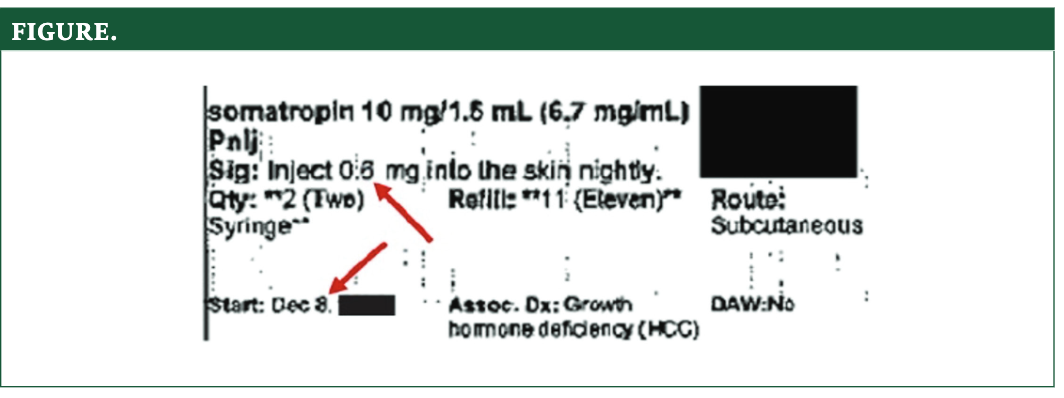Publication
Article
Pharmacy Times
Be Wary of the Wrong Dosing Unit Being Used in Directions
Author(s):
Specialty pharmacy reports case of alirocumab prescription with mg incorrectly typed instead of mL.
A prescription for alirocumab (praluent; Regeneron) 150 mg/mL prefilled pen with the directions “Inject 1 mL under the skin every 2 weeks” was dispensed with the directions “Inject 1 mg under the skin every 2 weeks.”
Alirocumab is a PCSK9 inhibitor dispensed by retail and specialty pharmacies and used for homozygous familial hypercholesterolemia, primary hyperlipidemia, or secondary prevention of cardiovascular events. The product is available as a single-use prefilled pen device, and the entire contents of the pen should be administered for a dose (1 mL total). The pen does not have dose markings or a mechanism to select a specific mg dose. It would be impossible to accurately measure 1 mg. In this case, a pharmacy technician inadvertently typed mg instead of mL as the dosing unit, and the error was not caught during preverification by the pharmacist or during final verification by a second pharmacist. When the error was discovered, the pharmacist corrected the directions and called the patient, who confirmed that he was taking the medication correctly.
The specialty pharmacy that reported this case does not have a standardized process for typing directions for pre-filled pens. The pharmacy writes the directions as close to what the doctor ordered, rather than changing them to be standardized and clearer for the patient.
For example, although the doctor wrote “inject 1 mL,” clearer and more instructive directions based on the design of the pen device would have been “inject the contents of 1 pen under the skin every 2 weeks.”
Pharmacies and prescribers should consider implementing a standardized sig code or directions for injectable products, making sure the directions match up with how the drug device is designed and how the prescribed dose is delivered. This can help reduce confusion at the pharmacy and for patients. Before new products are added to the inventory and available for dispensing, proactively assess for risks with dispensing, including possible confusion or opportunities to standardize the directions. Educate staff members about the risk for sig errors and provide a reference tool indicating how directions and dosages should be relayed to the patient on the label, such as mg, mL, or pen. Teach patients how to use pens. If this teaching is conducted in person or via videoconferencing technology, employ the teach-back method and have patients demonstrate how they will use the pen devices. If education is provided via telephone, have the patient verbalize how they will use the pen devices.
Poor Fax Quality Leads to Error
A specialty pharmacy received a new prescription for a somatropin pen injector for a patient with growth hormone deficiency. The prescription had a lower dose than what had been dispensed previously, and the patient’s parent was not aware of the dose reduction. While confirming the new dose, the pharmacist realized that the previous prescription had been dispensed incorrectly. The previous prescription had been faxed to the pharmacy, but the quality of the fax was poor with significant fax noise. The intended dose of 0.6 mg had been misread and dispensed as 0.8 mg. The start date was entered incorrectly as 12/8 instead of 12/6. The Figure shows how the numeral 6 in the sig field and start date field looks like the numeral 8. Thankfully, the incorrect dose of 0.8 mg daily did not harm the patient because it still fell within an acceptable dose range based on the patient’s weight.
The numeral 6 in the sig field and start date field, indicated by the red arrows, was misinterpreted as the numeral 8 due to the poor quality of the faxed prescription.

Fax noise, or the random marks and streaks on faxes, is an inherent problem with this technology, and it may be more common in old or poorly maintained fax machines. The ISMP has received many reports of errors related to the presence of extraneous interference, lines, or markings on prescriptions caused by old or poorly maintained equipment. Carefully review faxed prescriptions for fax noise.
If the transmission has fax noise in the area of the prescribed medication and directions for use, call the prescriber to confirm the prescription. Check the faxed order against the original, if available. Maintain fax machines, printers, and scanners according to manufacturer recommendations to ensure clear prescription images. Schedule regular maintenance of sending and receiving fax machines. If maintenance fails to improve fax quality, replace the machine. Notify prescribers if their equipment is contributing to poor fax quality
About the Author
Michael J. Gaunt, PharmD, is senior manager for error reporting programs and editor at the Institute for Safe Medication Practices (ISMP) in Horsham, Pennsylvania. He also serves as editor of the monthly ISMP Medication Safety Alert! Community/Ambulatory Care newsletter.

Newsletter
Stay informed on drug updates, treatment guidelines, and pharmacy practice trends—subscribe to Pharmacy Times for weekly clinical insights.





